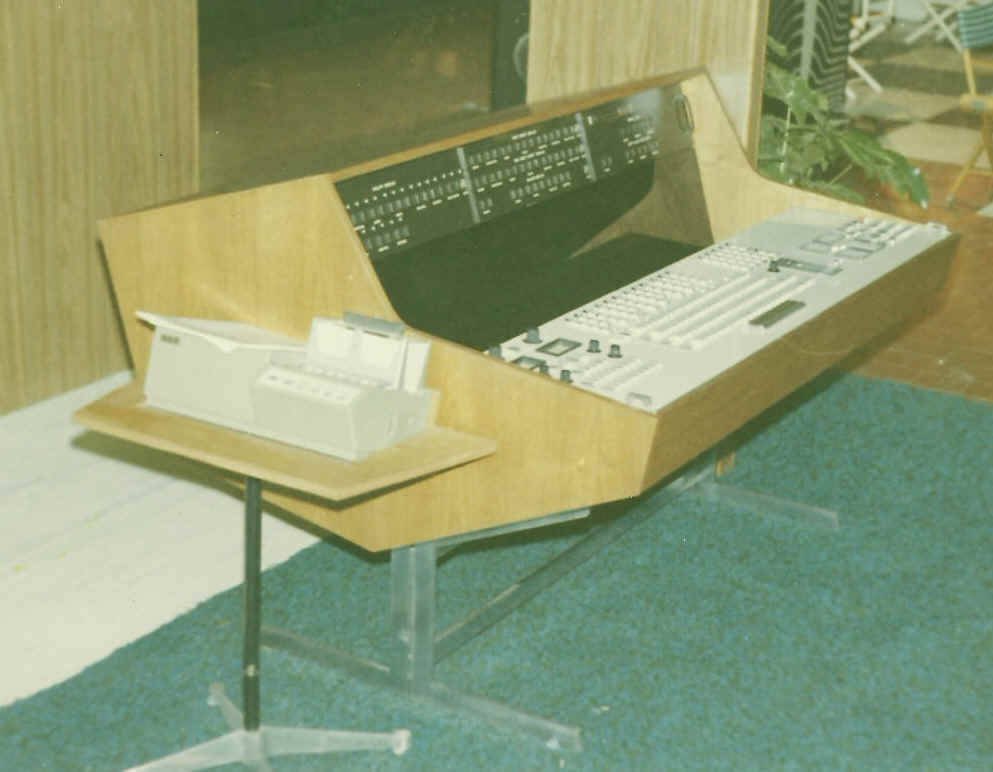|
|
Sarkes Tarzian
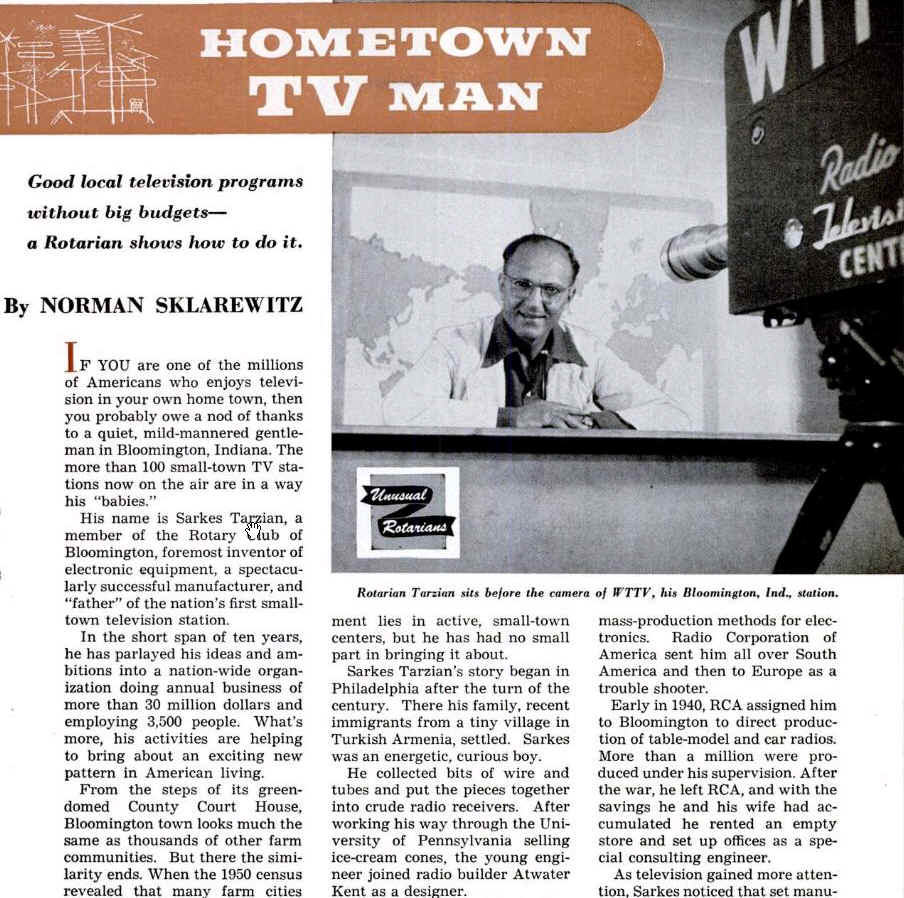

- "The Rotarian", June 1955, page 19 - with
a photograph
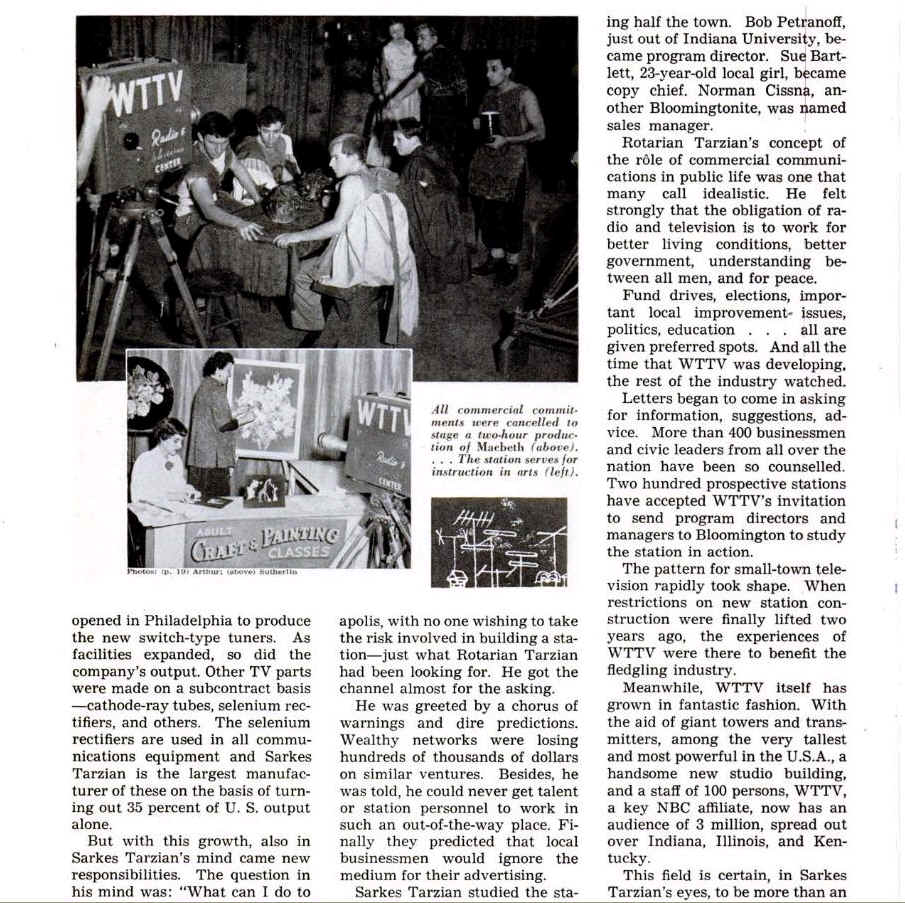
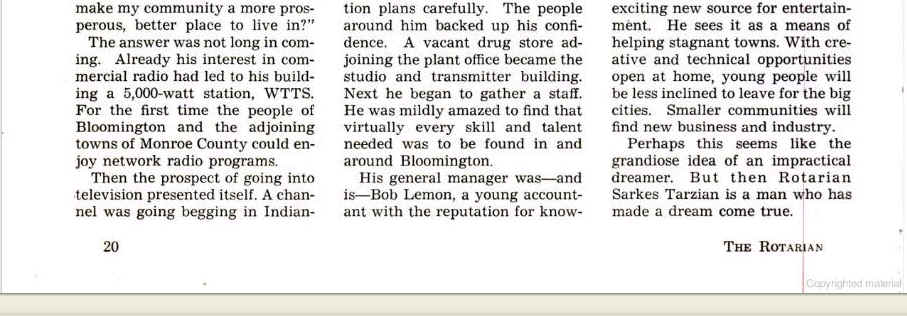
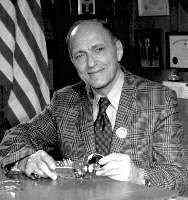
|
|
Sarkes Tarzian (son of Bedros
Tarzian and Aghavnie
Lulejian) was born 05 Oct 1900 in Kharpet (Harpoot) Armenia,
and died 17 Nov 1987 in Philadelphia, Penn. He married Mary
Mangigian on 1930 in Switzerland.
 Notes
for Sarkes Tarzian: Notes
for Sarkes Tarzian:
From passenger list:immigration 1907 Nov 8 Ellis Island aboard the
'President Lincoln' out of Le Harve. With 5 year old Sarkis are Artin
Tarzian,(m)24/27 (illeg),Khachkhatoun Tarzian,(f),Araski Tarzian 10
months.Artin is going to 'brother', Khachkhatoun to 'brother in
law',either Araski or Sarkis to their uncle: Neourk(illeg)Bedros Tarzian
at 1583 South St. in Philadelphia. Adoor Kayanjian (illeg, but this is a
best guess)is the nearest relative left behind in Harpoot as 'Father in
law', 'Father', and 'grandfather.
Artin is in the business of shoes. Artin has a scar on his right cheek,
and is 5ft 4 inches tall. Khachkatoon has a scar on her left cheek and is
4ft. 8inches.
From:<
Sarkes Tarzian*
Sarkes Tarzian, Inc.
Founder & President
A young immigrant from Turksih Armeneia, Sarkes Tarzian was just seven
years old when his father, who had come to the U.S. to escape persecution
of Christian Armenians by the Turks, saved enough money to send for his
family. Young Tarzian helped the family by working after school and
delivering newspapers and groceries. In 1918, he was the top high school
graduate in the city of Philadelphia, earning him a four-year,
all-expenses-paid college scholarship to the Univesity of Pennsylvania. He
earned his electrical engineering degree, and began a long career in the
radio\television manufacturing industry. In 1948, he designed a television
tuner that could produce high-quality results at low cost. He says,
"We’re thankful to the good Lord for the United States of America,
where people like us can come and be greeted with open arms. Here, if you
are interested and you are willing to put the effort in, you have the
chance to accomplish wonderful things.">>
Radio Engineer then chief engineer for A. Awater Kent.
Inventor of the Automobile Radio among other things.Electrical Engineer,
industrialist.(this info from Cyrus)
This is the info I have on his wife:
DR. MARY M. TARZIAN
Palm Beach, Florida
Mary Tarzian was president of the Young Women’s Christian Association
and graduated first in her class at the University of Pennsylvania. She
was also president of the National Student Council and the American
representative to the International Student Council. She holds a
master’s degree in political science and a doctorate in international
relations.
She was founder of the Eisenhower Memorial Foundation and co-founder, with
her husband Dr. Sarkes Tarzian, of Sarkes Tarzian Enterprises. The
Tarzians have two children.
Among Dr. Tarzian’s numerous awards and honors are the Kensington High
School Alumnae Award for Outstanding Achievement and an honorary L.L.D.
from Tri-State College, where she was the first woman in the school’s
one hundred year history to deliver the commencement address. The
University of La Verne bestowed an honorary doctorate in 1982-1983.
Dr. Mary M. Tarzian was an extraordinary woman, scholar and humanitarian.
She stated: “The development of the United States from a backward
country to a great nation is due in large measure to those pioneers who
had the courage to venture out on paths and projects untried by others, to
pit their strength and wits against the elements of their competitors. I
salute Northwood, admire it and support it because it upholds these
values.. Indeed, Northwood is playing a vital role by passing them on to
future generations.”
(Deceased 1998)>
<>The Pennsylvania Gazette:University of Pennsylvania:
Dr. Mary Mangigian Tarzian Ed’27 G’29 Gr’34, Palm Beach, Fla.,died
June 7, 1998. She had co-founded with her husband a company based in
Indianapolis that manufactured television equipment and set up radio and
television stations in Indiana, and later Chattanooga, Tenn., and Reno.
She was the author of The Armenian Minority
More About Sarkes Tarzian and Mary Mangigian:
Marriage: 1930, Switzerland.
Children of Sarkes Tarzian and Mary Mangigian are:
- +Patricia
Terzian, b. 18 May 1948, State Island.
- Thomas
Terzian.
Above from http://familytreemaker.genealogy.com/users/h/e/d/David-Hedison-MA/WEBSITE-0001/UHP-0309.html
Sarkes
Tarzian, Inc. included Nine [9] Divisions.
Corporate
Head Quarters was in Bloomington, Indiana
The
Tuner Division [Mfg TV Station Channel selector – TV Tuner]
The
Rectifier Division [Mfg semi-conductors]
The Air
Trimmer Division [Mfg Variable Capacitors]
The
Broadcast Equipment Division [Mfg TV broadcast Equipment]
The Tape
Division [Mfg Audio Recording tape]
The News
Paper division [Published a local Newspaper]
TV &
Radio Division [operated 2 TV stations & 3 Radio stations]
[Indianapolis & Fort Wayne Indiana]
Other
divisions:
The Tube
Division - Batavia, Illinois [Mfg CRT]
The
Eastern Division – Philadelphia, PA [Mfg Custom designed FM
radios]
[Customized Sub-carrier]
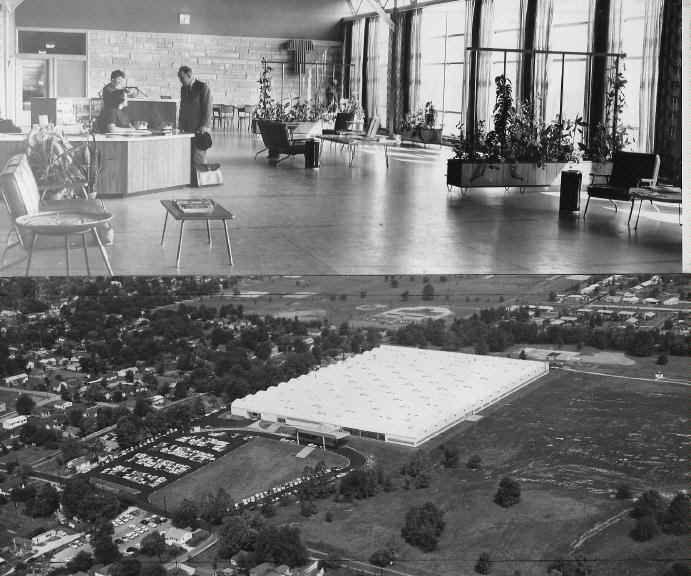
SARKES TARZIAN, INC.
LOBBY AND MAIN PLANT
BLOOMINGTON INDIANA
Pre
1960's
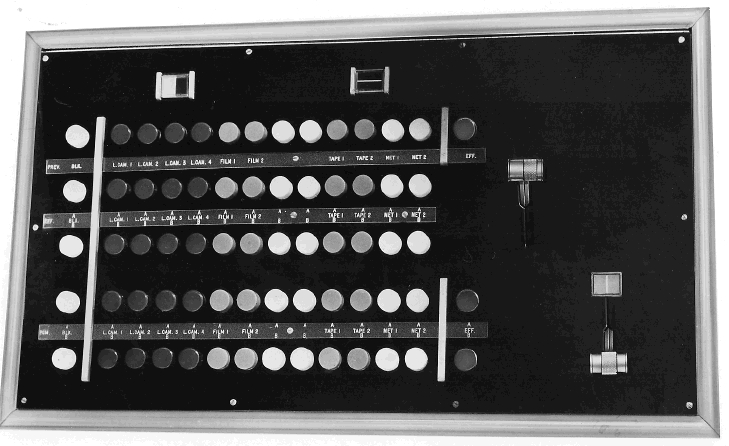
Studio
Dual Channel Video switching system
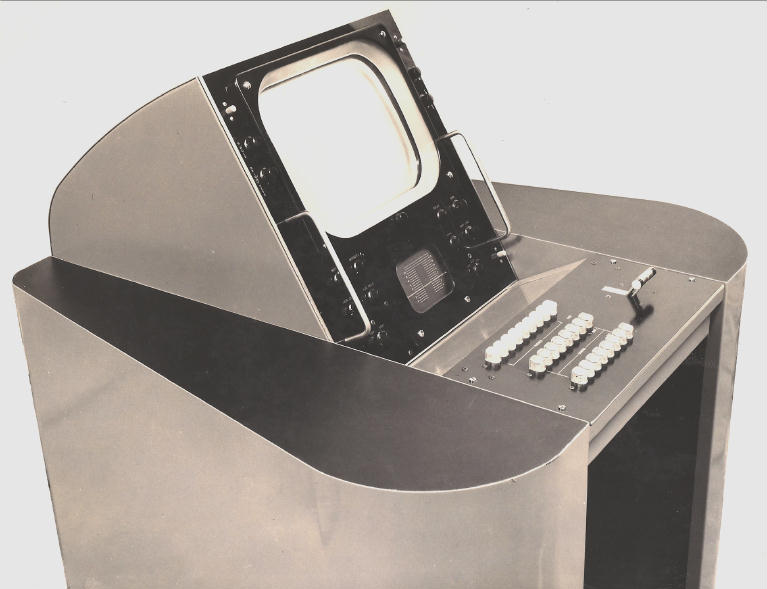
Mid 50's studio
switching system console
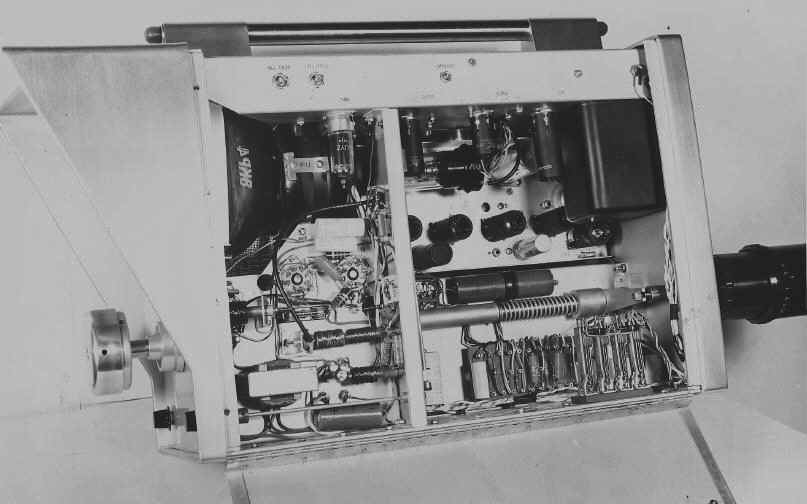
Model
880 Vidicon/Plumbicon studio camera
- cover open - 4 lens turret and
built-in viewfinder
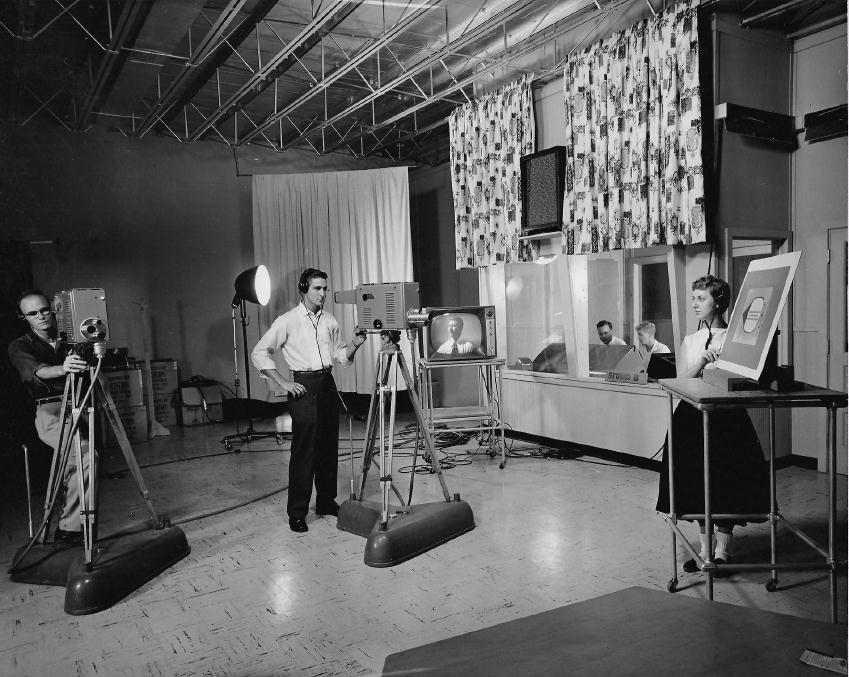
Typical
studio set-up of the 50's and early 60's - The control room
with direct view of the studio. Two early Sarkes Tarzian Vidicon
cameras in use in this
view.
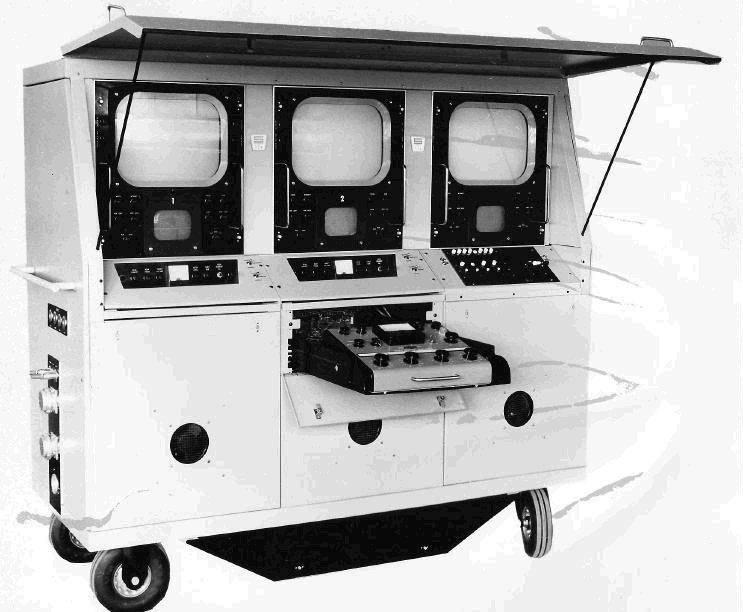
A
portable mini-studio control console with Audio/Video
control and
connections for Cameras, microphones, etc..

Heterodyne
Microwave Repeater
(Maintained
integrity of signal by not
demodulating and remodulating the signal).
|
| |
|
The 1960's
>>>
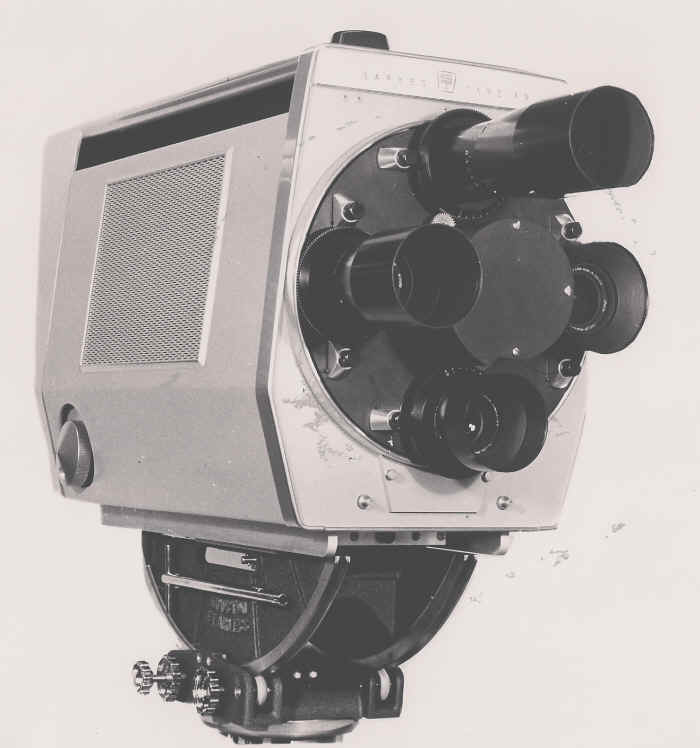
Image
Orthicon camera
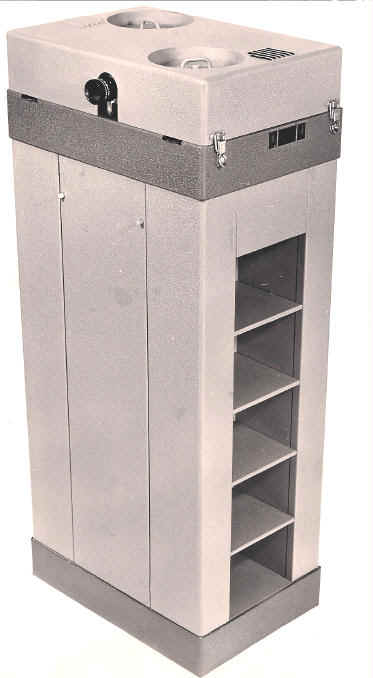
Dual
Random Access 200 slide projector
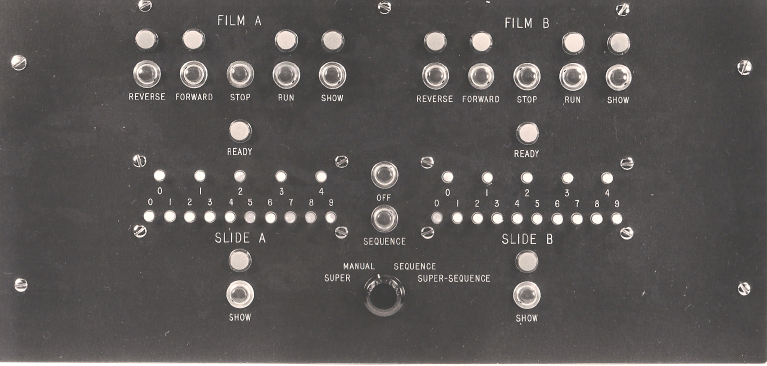
One
version of the Film - Slide Projector Control Panel
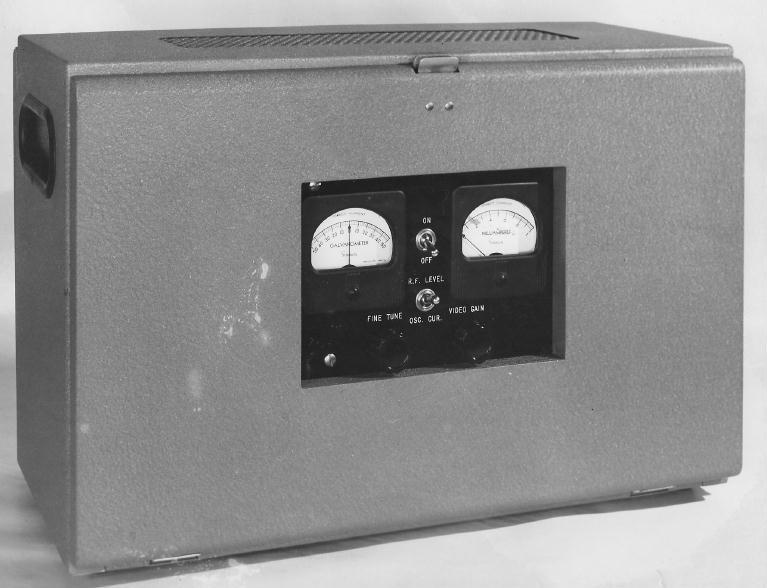
Portable
Microwave Receiver - 2000 MHz Band
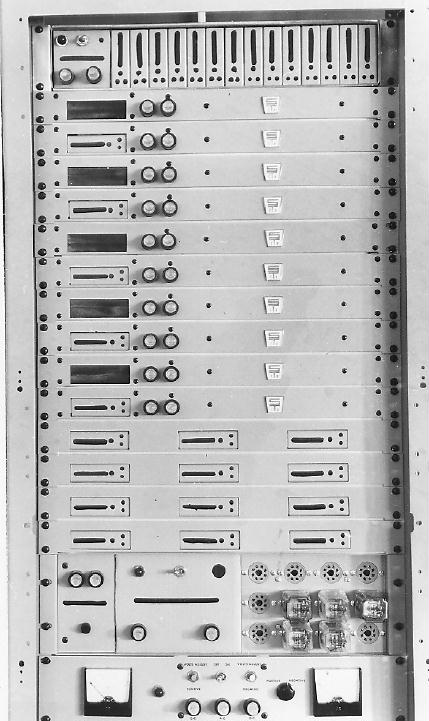
Pulse
and Video distribution rack
with
Machine Control facilities.
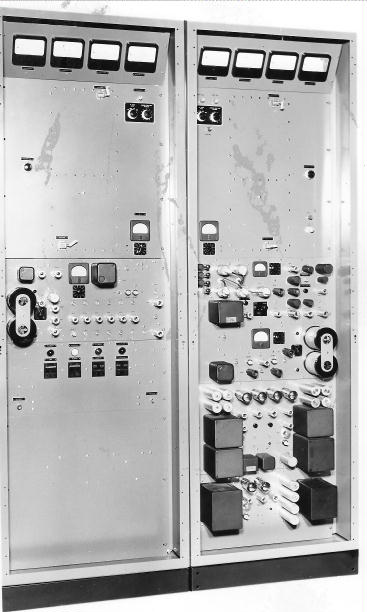
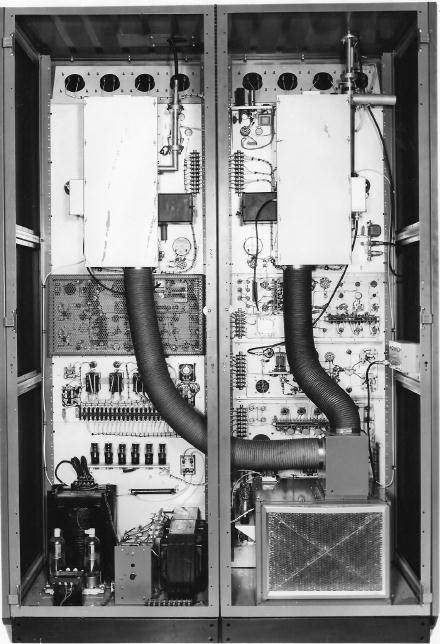
SARKES
TARZIAN
STV
1000 AH TV TRANSMITTER
SARKES
TARZIAN TV AUTOMATION
As you may be
aware Sarkes Tarzian Broadcast Equipment Division was one of the pioneers
in TV Automation of the Master Control studio.
The first
full automation system provided for complete automatic control of cameras,
slide and film projectors [including pre-roll timing] and associated
Multiplexer, and video/audio switching control. Once
programmed the operator merely monitored the action – but could step in
at any time to manually override in the event of a problem as film
breakage, etc..
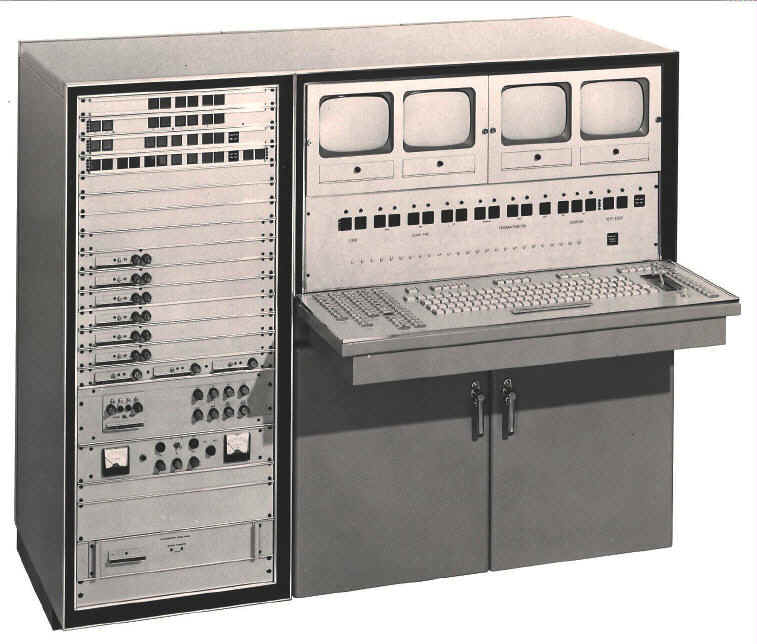
These Photos
are from the original seminar where some industry station engineers were
invited to witness the device in action.
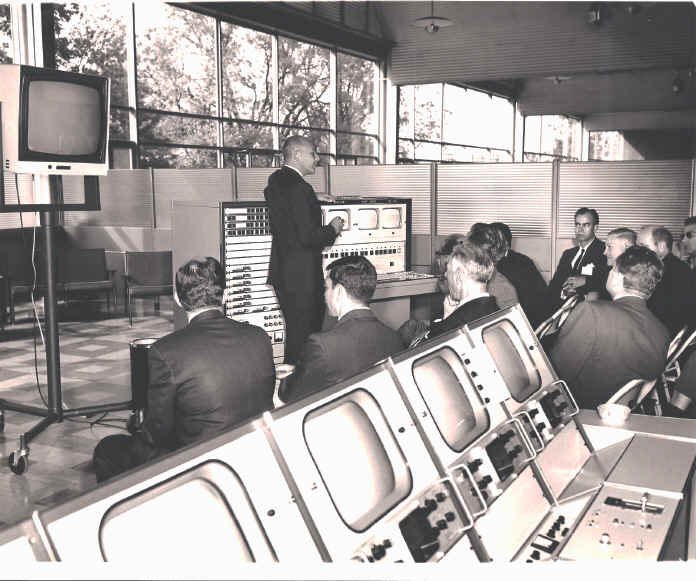
Two models
were manufactured – this model was before solid state
memory was available and used a unique ultrasound delay- line memory
design. A subsequent model was manufactured when the
more modern solid state delay became available.
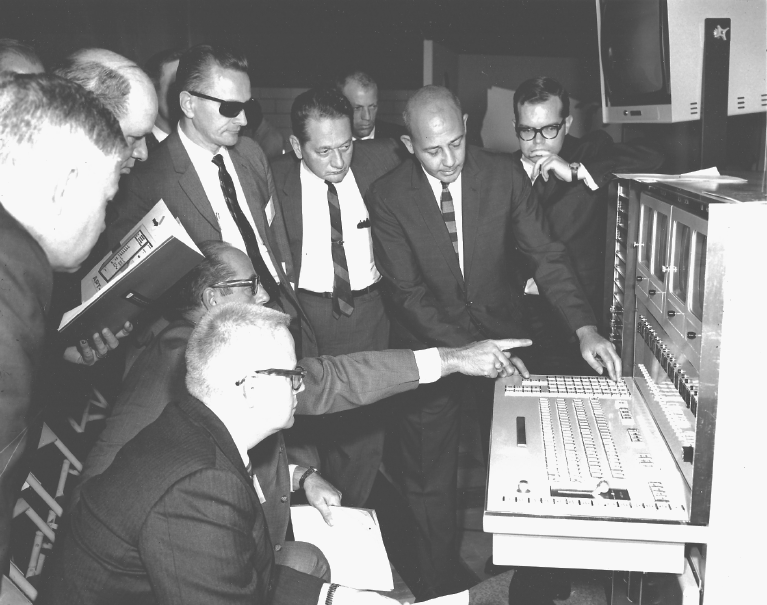
Final version of the Automated Master Control console
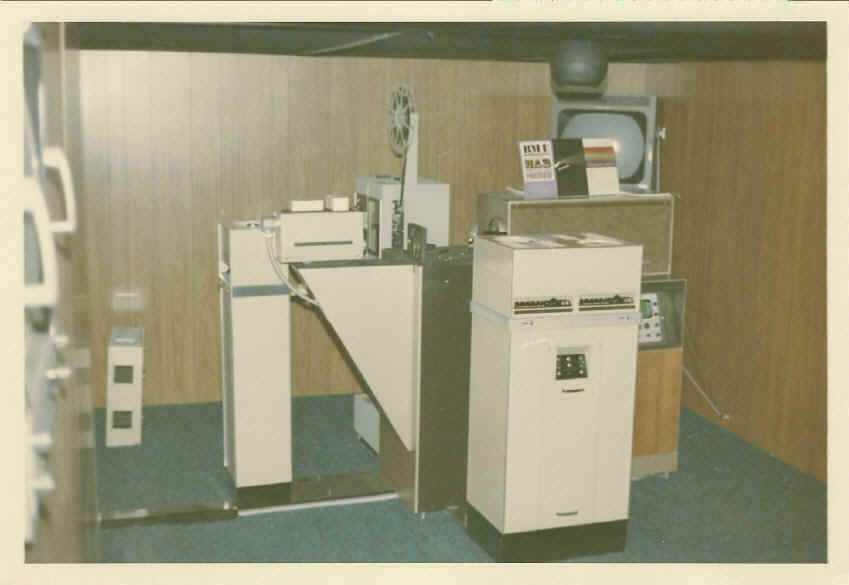
Film/Slide System [monochrome & color cameras]. Film Projector
at rear is a Sarkes Tarzian design as is the dual random access slide
projector in the foreground an the single random access slide projector
on the left side. Color pickup camera on the right and monochrome
Plumbicon on the left. ( Optical Multiplexer has its cover
removed)
|
|
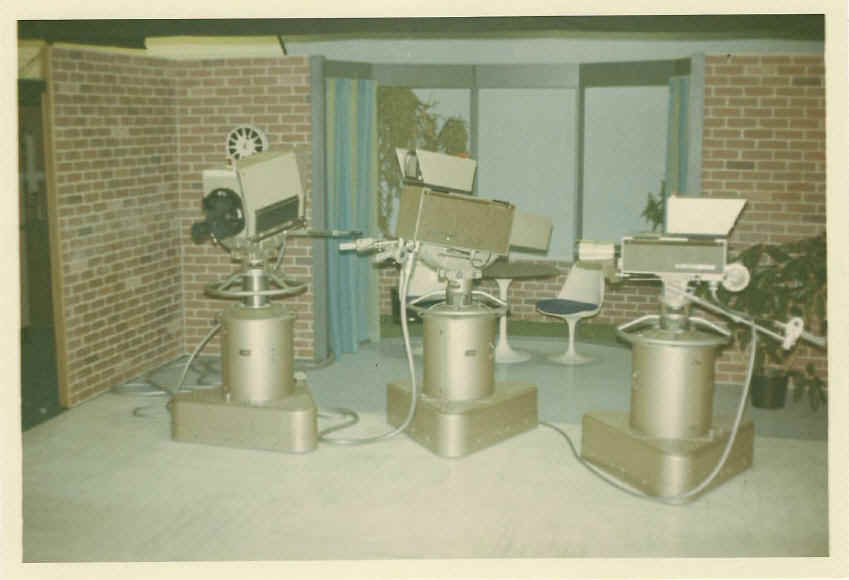
Three studio camera versions: Left to right - Image Orthicon camera -
Polychrome III color camera - Plumbicon camera
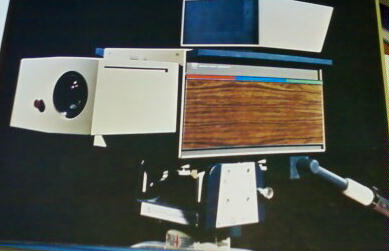
Sarkes Tarzian Polychrome 88 - technical data
online soon!
|
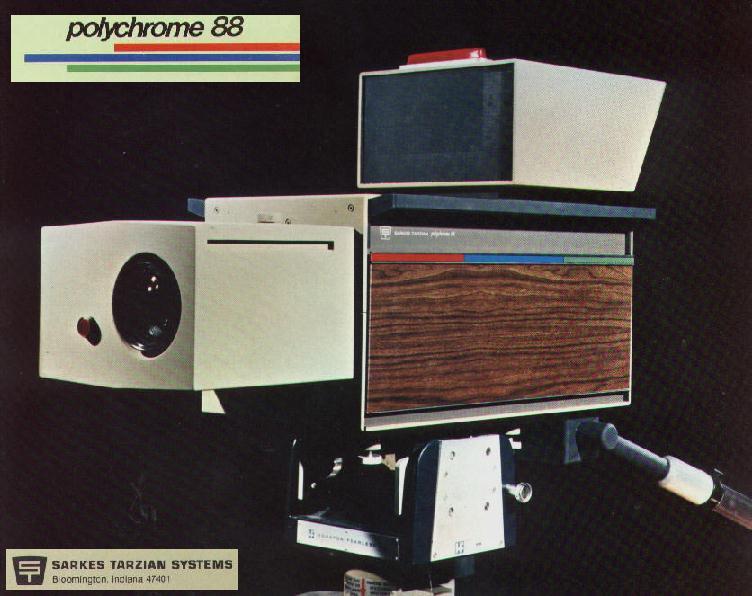
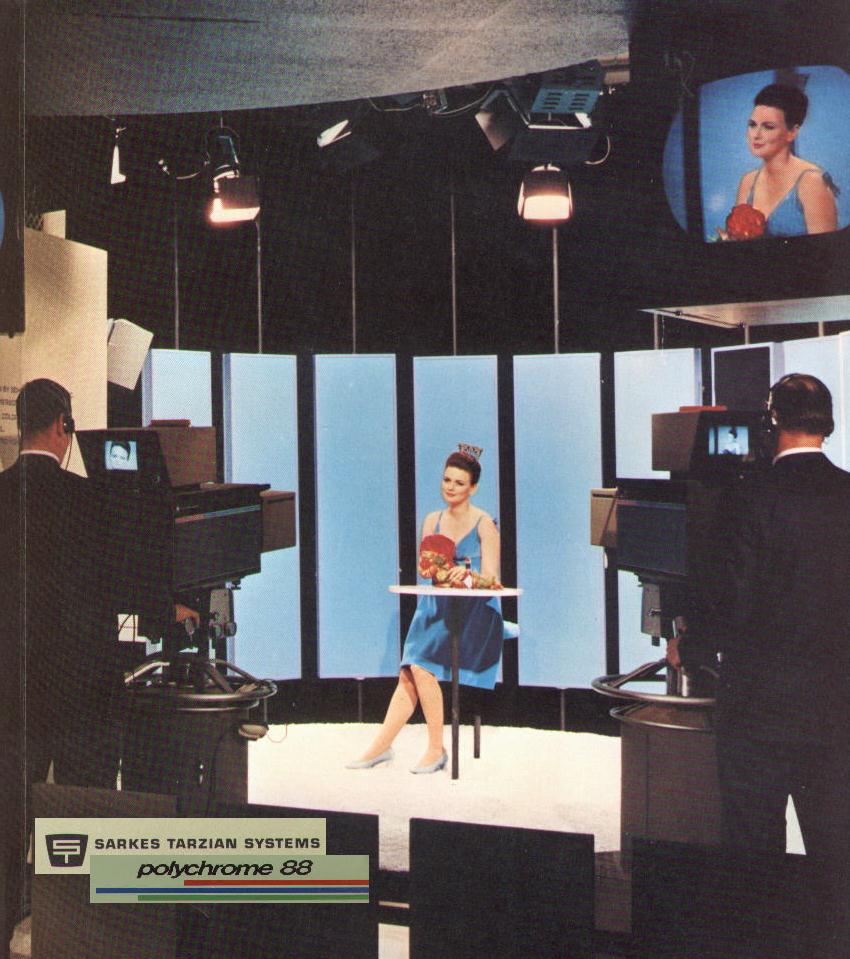
Here another Photo of the Polychrome 88 for your website. I
worked for
RCA Broadcast division and took photos of all the exhibits.
One of these
is the same in 2 different sizes. You can cut out a close-up of the
camera from the larger one. The other is a composite photo I
made for a
slide presentation scanning the P-88 brochure.
Note: Just like the Ford Edsel, the Polychrome 88's design was ahead of
its time, with the external viewfinder on top instead of being built into
the camera head like all other MFRs.
Lytle Hoover
former RCA B/C Division Market Research Administrator
|
later days -
Address: P.O. Box 62, Bloomington, IN 47402-0062
Address: 205 N. College Ave., Bloomington, IN 47404-3950
Phone: 812.332.7251
FAX: 812.331.4575
Web Presence:
Owner: Sarkes Tarzian (Deceased 7 October 1987)
President - Radio: R. Geoffrey Vargo
stations
KTVN-TV, Reno, Nevada
WAJI (nee WFWQ)
WATI
(Sold)
WGCL (nee WTTS(AM))
WLDE (nee WJLT)
(Purchased from Fairfield
Broadcasting in April, 1993 for $1.5 million.)
WRCB-TV, Chattanooga, Tennessee
WTTS (nee WGTC-FM)
|
| Sarkes Tarzian (1900-October 1987) was an Armenian-born
US engineer, inventor, and broadcaster. In 1907, he and his family
immigrated to Philadelphia,
Pennsylvania, in the United States. He attended the University
of Pennsylvania and received an undergraduate degree in 1924 and a
graduate degree in 1927. Tarzian worked for the Atwater
Kent company and then for RCA
in Bloomington,
Indiana.
He founded the manufacturing company Sarkes Tarzian Enterprises
in 1944, and was involved in early experiments in VHF
audio broadcasting in 1946. Tarzian was a member of the Rotary
Club. In 1949 he started television station WTTV
in Bloomington. He sold that station in 1978.
The Sarkes Tarzian company was an important manufacturer of radio and
television equipment, television tuners, and components. Its FM
radio receivers helped to popularize the broadcast medium. The
manufacturing operations were spun off in the 1970s and today the company
still exists as a broadcaster, owning several television and radio
stations. Gray
Television has owned a partial stake in Sarkes Tarzian, Inc., since
the early 2000s.
He was survived by his wife Doctor Mary Mangigian Tarzian (1905-June
1998). They had two children.
The Sarkes and Mary Tarzian Nature Preserve in Bloomington, Indiana
commemorates their names.
Delbert Charles Miller, The history of Sarkes Tarzian, Inc: The
story of Sarkes Tarzian and Mary Tarzian and the industrial company they
built, 1993
Company Overview
Sarkes Tarzian, Inc. operates as a radio and television
management company. The company owns and operates television and radio
stations. Sarkes Tarzian, Inc. was founded in 1944 and is based in
Bloomingdale, Indiana.
205 North College Avenue
Suite 800
Bloomington, IN 47404
United States
Founded in 1944
|
|
|
|
|
|
Spring 2011 :: MECH&AE 133A, Sec.1
:: Engineering Thermodynamics :: Class Homepage
Warning Message(s):
- Students/guests no longer have access to past
content after the class has ended.
- You are not logged in so you are viewing the public
display of the class website.
Class Instructor(s)
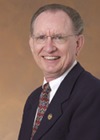
Wilbur Marner: Dr.
Webb Marner has been affiliated with the Mechanical and
Aerospace Engineering (MAE) Department at UCLA since October
1991 and is presently an Adjunct Professor in the
Department.
On April 1, 2006 he retired from Caltech's Jet Propulsion
Laboratory with nearly 26 years of service to JPL. During
that time he held a number of positions including that of
Manager of the Measurement, Test & Engineering Support
Section from May 1995 to October 2004. Previously, Dr.
Marner served on the staff of Heat Transfer Research, Inc. (HTRI)
in Alhambra, California and on the faculty of the South
Dakota School of Mines & Technology in Rapid City. He
has also been a Lecturer at California State University, Los
Angeles and California State University, Northridge. He
began his professional career with Sarkes Tarzian, Inc. in
Bloomington, Indiana where he was involved with the quality
control in the manufacturer of television tuners.
Dr. Marner is a member of the American Society of Mechanical
Engineers (ASME), American Institute of Aeronautics and
Astronautics (AIAA), Society of the Sigma Xi, American
Society for Engineering Education (ASEE), and The Planetary
Society. He is a Fellow Member of ASME and has actively
participated in the Society's programs over the past 38
years including a three-year term as a member of the Board
of Governors. He is presently ASME Secretary & Treasurer
and is the 2009 recipient of the Society's 2009 Edwin F.
Church Medal for "sustained contributionss to
mechanical engineering education."
Dr. Marner received his BS and MS degrees from Purdue
University and PhD from the University of South Carolina,
all in mechanical engineering. He is the author or co-author
of over 60 technical papers, reports, and other publications
-- primarily in the thermal sciences -- and co-inventor of
two U.S. patents
|
|
|
Ed,
RE
You're questions - I’ll try to respond using your numbering:
1
- My one memorial encounter with electronics as a youngster around
15 years old was when our Midwest Radio – a console about 3 ft
high and two ft wide that had maybe 20 tubes and a series of IF
coils – but wasn’t receiving signals too well.
It
had been a gift from a neighbor who actually had a job and could
purchase something like that – he had purchased a new one
because of the poor performance and he gave his old one to us and
it was a thing to admire.
I
decided maybe I could ‘fix’ it so I took the back off and
looked inside - Of course I didn’t know they were IF coils
but each had a couple of screws on top and I discovered that every
one of them was not tightened down! So I tightened them and
the Radio was forever silent. I can’t really
call my dad’s reaction as a lecture – it was a tight-lipped
masterpiece of self-control.
2-
I worked on about 17 different Radars during WW II – I do
not recall the part numbers – I think the earliest one was an
SCR 276 a low frequency Radar using a large ‘screen’ type
antenna system with multiple phased dipoles spread across the
surface and an Amplidyne [?] rotator system.
The
Radars ranged from 200 mHz to 3000 MHz systems using parabola
antennas In those days the Magnetron was a top secret
tube and are now common in every household’s microwave oven.
3-
My interest in Television began and ended with the Tarzian years.
My
early interest was in auto mechanics – I went to Arsenal
Technical High School in Indianapolis where I took three years of
auto mechanics and I didn’t really become interested in
electronics until one visit to the library looking for information
on automobiles I ran across a book by Ghiaradi [?] it as filled
with schematics and math explaining how each circuit functioned
and I found it fascinating – took the book out and renewed it
several times.
Electronics
became by primary interest.
4-
I loved Los Angeles –
Fairly
fresh out of the service finding work was not a big problem.
My first try was at a small outfit on Pico Blvd called Bel Canto
Radio– they were advertising for a technician – it was run by
a German Jew who had escaped Hitler’s Germany before the
war … he had designed a TRF AM receiver that he customized
building them into walls and furniture for mainly the
“Hollywood” community.
(these
were clients with lots of money and weird tastes – I once built
a radio hi-fi system in the base of an antique $3000 toilet
stool – when you opened the lid the radio came on)
The
work entailed both the repair of and installation of his own and
other commercial radio equipment – not much FM in those days
[but that’s a story in its own right].
While
Superheterodyne receivers were the radio of preference for
most the TRF [tuned radio frequency] radio had slightly better
quality for AM signals because the bandwidth..and selectivity
didn’t seem a problem because the radio spectrum was not
saturated with hundreds stations on air.
He
had a partner who owned a record store on Wilshire Blvd.
Turns out his clients were mainly the large Jewish community of
the Hollywood movie industry…writers, composers, etc., and some
big time actors of the day too.
I
was able to meet several during the course of working at Bel Canto
in their homes where I went to ‘fix’ something – that almost
always meant replacing a tube. I have autographed
‘clarinet reeds’ from Benny Goodman, e.g., he had
one of the first BrushTape Recorders which was the reason for my
meeting him.
Anyway
I didn’t stay in LA only because when I looked into going to
UCLA they would not honor some credit hours from Butler University
I had accumulated and even though it was only 3 or 4 – I really
do not recall how many - I felt strongly they should have
accepted them – so I decided to return to IU in Bloomington.
5-
Construction of WTTV was a memorial time – all night working
sessions – construction of all the studio equipment from video
and pulse distribution amplifiers, sync Generators, video
switching systems, monitors, consoles, slide projectors, audio
systems, cameras, flying spot slide unit, transmitter, diplexer
and even the bat wing antenna for Channel 10!
The design of the microwave path for interconnection to the
network out of Cincinnati requiring two intermediate sites from an
Off-air point about 30 miles form Cincinnati – Brown County
State Park is right in the path and has high elevations.
The
exposure to such a wide range of electronic and mechanical design
issues could never have been duplicated in any other venue.
That
group at Sarkes Tarzian was fearless in taking on such a mind
boggling task. The primary engineer, Mort Weigel, {no
degree} was a beer drinking, joke telling, phenomena of talent –
from metal working, chemical treatment, electrical – mechanical,
and electronic design, nothing was outside his abilities to
undertake.
I
probably learned more in those times of construction of WTTV –
spanning a range of mechanical and electronic design - than I
would have in a lifetime under other circumstances.
6-
I know of no equipment items that from those years – but some
may exist – if they do they are likely in the possession of
Thomas Tarzian.
**************************************************************************************
On Wed, Nov 16, 2011 at 2:37 AM, <COURYHOUSE@aol.com>
wrote:
Hi Again! A few questions
on your bio to fill in..
1- when you were a child did you
experiment with radio and electronics? tell me about ....
2 - in WW2 you worked with
radar sets. do you remember the nomenclature of these
sets?
please details!!!! (by
the way we have radar, countermeasures and
iFF in the museum here too!!!!!!)
3- what was your earliest
experiences in experimenting with television????
4- after the war you
worked in radio and TV in the Los Angles area... where in LA
and what Company.... what products what areas
were you responsible... did you like LA?
5.- can you give me more memory on
construction of WTTV?
6- is there any early equipment left
from WTTV??
thanks Ed!
Ed,
RE
You're questions - I’ll try to respond using your numbering:
1
- My one memorial encounter with electronics as a youngster
around 15 years old was when our Midwest Radio – a console
about 3 ft high and two ft wide that had maybe 20 tubes and a
series of IF coils – but wasn’t receiving signals too
well.
It
had been a gift from a neighbor who actually had a job and could
purchase something like that – he had purchased a new one
because of the poor performance and he gave his old one to us and
it was a thing to admire.
I
decided maybe I could ‘fix’ it so I took the back off and
looked inside - Of course I didn’t know they were IF coils
but each had a couple of screws on top and I discovered that every
one of them was not tightened down! So I tightened them and
the Radio was forever silent. I can’t really
call my dad’s reaction as a lecture – it was a tight-lipped
masterpiece of self-control.
2-
I worked on about 17 different Radars during WW II – I do
not recall the part numbers – I think the earliest one was an
SCR 276 a low frequency Radar using a large ‘screen’ type
antenna system with multiple phased dipoles spread across the
surface and an Amplidyne [?] rotator system.
The
Radars ranged from 200 mHz to 3000 MHz systems using parabola
antennas In those days the Magnetron was a top secret
tube and are now common in every household’s microwave oven.
3-
My interest in Television began and ended with the Tarzian years.
My
early interest was in auto mechanics – I went to Arsenal
Technical High School in Indianapolis where I took three years of
auto mechanics and I didn’t really become interested in
electronics until one visit to the library looking for information
on automobiles I ran across a book by Ghiaradi [?] it as filled
with schematics and math explaining how each circuit functioned
and I found it fascinating – took the book out and renewed it
several times.
Electronics
became by primary interest.
4-
I loved Los Angeles –
Fairly
fresh out of the service finding work was not a big
problem. My first try was at a small outfit on Pico
Blvd called Bel Canto Radio– they were advertising for a
technician – it was run by a German Jew who had escaped
Hitler’s Germany before the war … he had designed a TRF
AM receiver that he customized building them into walls and
furniture for mainly the “Hollywood” community.
(these
were clients with lots of money and weird tastes – I once built
a radio hi-fi system in the base of an antique $3000 toilet
stool – when you opened the lid the radio came on)
The
work entailed both the repair of and installation of his own and
other commercial radio equipment – not much FM in those days
[but that’s a story in its own right].
While
Superheterodyne receivers were the radio of preference for
most the TRF [tuned radio frequency] radio had slightly better
quality for AM signals because the bandwidth..and
selectivity didn’t seem a problem because the radio
spectrum was not saturated with hundreds stations on air.
He
had a partner who owned a record store on Wilshire
Blvd. Turns out his clients were mainly the large
Jewish community of the Hollywood movie industry…writers,
composers, etc., and some big time actors of the day too.
I
was able to meet several during the course of working at Bel Canto
in their homes where I went to ‘fix’ something – that almost
always meant replacing a tube. I have autographed
‘clarinet reeds’ from Benny Goodman, e.g., he had
one of the first BrushTape Recorders which was the reason for my
meeting him.
Anyway
I didn’t stay in LA only because when I looked into going to
UCLA they would not honor some credit hours from Butler University
I had accumulated and even though it was only 3 or 4 – I really
do not recall how many - I felt strongly they should have
accepted them – so I decided to return to IU in Bloomington.
5-
Construction of WTTV was a memorial time – all night working
sessions – construction of all the studio equipment from video
and pulse distribution amplifiers, sync Generators, video
switching systems, monitors, consoles, slide projectors, audio
systems, cameras, flying spot slide unit, transmitter, diplexer
and even the bat wing antenna for Channel 10!
The design of the microwave path for interconnection to the
network out of Cincinnati requiring two intermediate sites from an
Off-air point about 30 miles form Cincinnati – Brown County
State Park is right in the path and has high elevations.
The
exposure to such a wide range of electronic and mechanical design
issues could never have been duplicated in any other venue.
That
group at Sarkes Tarzian was fearless in taking on such a mind
boggling task. The primary engineer, Mort Weigel, {no
degree} was a beer drinking, joke telling, phenomena of talent –
from metal working, chemical treatment, electrical – mechanical,
and electronic design, nothing was outside his abilities to
undertake.
I
probably learned more in those times of construction of WTTV –
spanning a range of mechanical and electronic design - than I
would have in a lifetime under other circumstances.
6-
I know of no equipment items that from those years – but some
may exist – if they do they are likely in the possession of
Thomas Tarzian.
|
|
|
